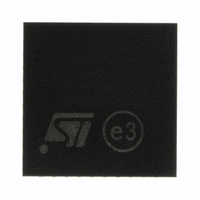SN260Q STMicroelectronics, SN260Q Datasheet - Page 16

SN260Q
Manufacturer Part Number
SN260Q
Description
IC ZIGBEE/802.15.4 PROC 40-QFN
Manufacturer
STMicroelectronics
Datasheet
1.SN260Q.pdf
(47 pages)
Specifications of SN260Q
Frequency
2.4GHz
Modulation Or Protocol
802.15.4
Applications
ZigBee™
Power - Output
-32dBm ~ 5dBm
Sensitivity
-97.5dBm
Voltage - Supply
2.1 V ~ 3.6 V
Current - Receiving
35.5mA
Current - Transmitting
35.5mA
Data Interface
PCB, Surface Mount
Antenna Connector
PCB, Surface Mount
Operating Temperature
-40°C ~ 85°C
Package / Case
40-QFN
For Use With
497-6404 - BOARD EVAL SPZB260 MOD FOR STR9497-5990 - KIT EVAL REVA FOR ZIGBEE497-5879 - NETWORK DEVELOPMENT FOR SN260497-5877 - KIT RADIO CARRIER FOR SN260
Lead Free Status / RoHS Status
Lead free / RoHS Compliant
Memory Size
-
Data Rate - Maximum
-
Functional description
6.3
6.4
16/47
Integrated MAC module
The SN260 integrates critical portions of the IEEE 802.15.4-2003 MAC requirements in
hardware. This allows the SN260 to provide greater bandwidth to application and network
operations. In addition, the hardware acts as a first-line filter for non-intended packets. The
SN260 MAC utilizes a DMA interface to RAM memory to further reduce the overall
microcontroller interaction when transmitting or receiving packets.
When a packet is ready for transmission, the software configures the TX MAC DMA by
indicating the packet buffer RAM location. The MAC waits for the backoff period, then
transitions the baseband to TX mode and performs channel assessment. When the channel
is clear, the MAC reads data from the RAM buffer, calculates the CRC, and provides 4-bit
symbols to the baseband. When the final byte has been read and sent to the baseband, the
CRC remainder is read and transmitted.
The MAC resides in RX mode most of the time, and different format and address filters keep
non-intended packets from using excessive RAM buffers, as well as preventing the SN260
CPU from being interrupted. When the reception of a packet begins, the MAC reads 4-bit
symbols from the baseband and calculates the CRC. It assembles the received data for
storage in a RAM buffer. A RX MAC DMA provides direct access to the RAM memory. Once
the packet has been received, additional data is appended to the end of the packet in the
RAM buffer space. The appended data provides statistical information on the packet for the
software stack.
The primary features of the MAC are:
●
●
●
●
●
●
●
●
●
●
●
Packet trace interface (PTI)
The SN260 integrates a true PHY-level PTI for effective network-level debugging. This two-
signal interface monitors all the PHY TX and RX packets (in a non-intrusive manner)
between the MAC and baseband modules. It is an asynchronous 500 kbps interface and
cannot be used to inject packets into the PHY/MAC interface. The two signals from the
SN260 are the frame signal (PTI_EN) and the data signal (PTI_DATA). The PTI is supported
by InSight Desktop.
CRC generation, appending, and checking
Hardware timers and interrupts to achieve the MAC symbol timing
Automatic preamble, and SFD pre-pended to a TX packet
Address recognition and packet filtering on received packets
Automatic acknowledgement transmission
Automatic transmission of packets from memory
Automatic transmission after backoff time if channel is clear (CCA)
Automatic acknowledgement checking
Time stamping of received and transmitted messages
Attaching packet information to received packets (LQI, RSSI, gain, time stamp, and
packet status)
IEEE 802.15.4-2003 timing and slotted/unslotted timing
SN260












